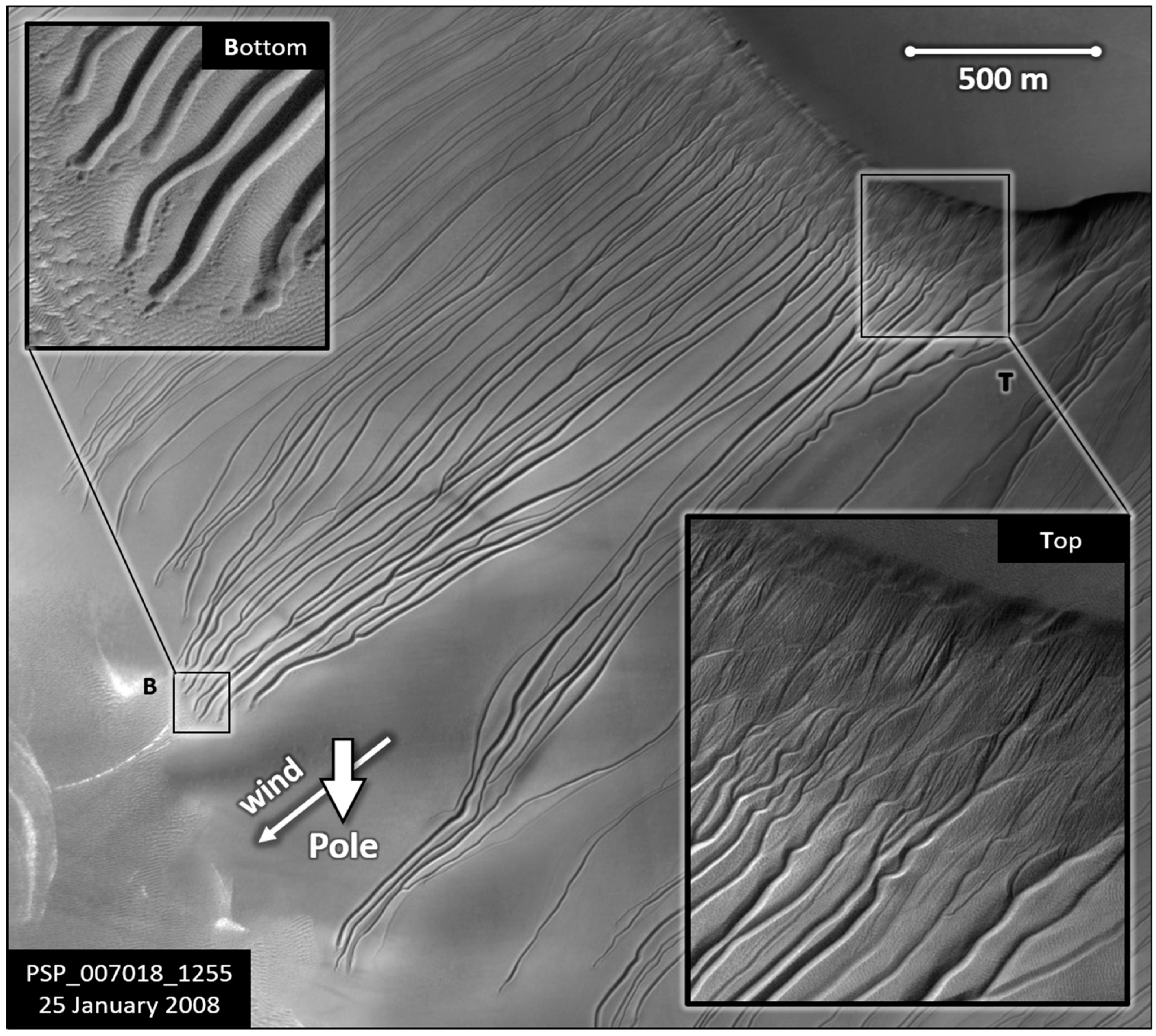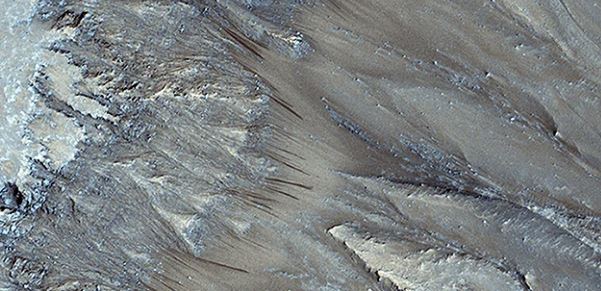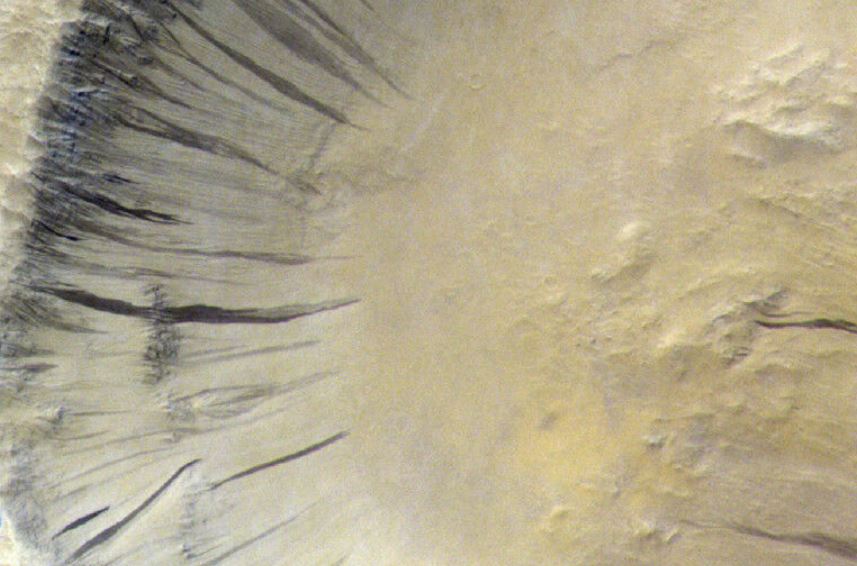Is there liquid water on the surface of Mars? The dark stripes and the « gullies »: what they are and what they tell us on the red planet

According to a new research that has used automatic learning techniques, the Martian striated slopes would be dried and tied to wind and dust. But maybe things are not quite like that
Is there liquid water on Mars? The question, without still a definitive answer, has generated several hypotheses over the years and is now the subject of great interest in view of future shipments on the red planet. It is believed that about 3.7 billion years ago Mars was a warmer and damp planet, with lakes and oceans that covered part of its surface. The very low pressure of the Martian atmosphere, however, makes the stable presence of liquid water impossible today. The Martian environment permanently supports only the presence of ice (to the poles and probably in the subsoil, trapped as permafrost) which can go directly from the solid state to the gaseous state, without going to the liquid state.
Although modern Mars is considerably dry and the temperatures rarely exceed the zero, however, could potentially be possible to appear small quantities of water, perhaps from the ice of the subsoil, from underground water reserves or, the last hypothesis, from unusual air. If it were true, rare habitable niches in a desert world could exist.
The sign of this water could hide in the mysterious clear and dark streaks and in the canals that run along the rocky walls and in the craters of Mars, for years observed by scientists.
The Marzian Calanche
A study of some time ago conducted by the geophysics of the National Institute of Geophysics and Vulcanolgia (Ingv) Adriano Nardi and Antonio Piersanti had hypothesized how the spring water could form Marzian calanche (Gullies) through the seasonal merger of the permafrost, the ice remained trapped in the ground in past eras. More recently their new job has observed even more particular phenomena, i Linear Gullieschannels that could be generated by the frost. « In a recurring seasonal cycle – explain the Italian researchers – during the first days of the Martian spring, in the presence of winds of wind, could condense water in the liquid state in a transient way ».
The Martian striated slopes
But now a new study conducted by Brown University scientists in the United States and the University of Bern published on Nature Communications would question the hypothesis that some traces (clear and dark streaks observed thanks to satellite images are actually the sign of a flow of water: according to researchers The identified strips would be dry and related to the wind activity and the movement of the dust.
These strange stripes (striated slopes) cited at the work of Nature, were photographed for the first time in the seventies by the mission NASA Viking. These structures are usually darker than the surrounding land and extend for hundreds of meters on sloping soils. Some persist for years or decades, while others come and go faster. The strips that appear and disappear more quickly (called recurring slope linee RSL) seem to reappear in the same points during the hottest periods of the Martian year.

The automatic learning algorithm
For investigate the phenomenon of striated slopes the scientists have used Automatic learning techniques (specially trained neuronal networks) to analyze and catalog beyond 86 thousand high resolution satellite images and thus create a global map containing more than 500 thousand streaks of Martian slope. « Once this map was obtained, we were able to compare it with databases and other parameters such as temperature, wind speed, hydration, landslides and other factors, » said Valentin Bickel, researcher at Bern University, a work author with Adomas Avlantinas, post-dental researcher at Brown University in the United States.
The two scientists hypothesize that both types of streaks probably form through dry avalanches of dust triggered by the wind and impactie would not be attributable to watery processes. «Our study – concludes the researchers – examined all these characteristics, but He found no proof of the presence of water. Our model privileges dry training processes ».
The geostatic analysis of the soil
The geostatic analysis has in fact highlighted that the striated slopes and the RLS are generally not associated with factors that suggest a liquid or icy origin, such as a specific orientation of the slope, high fluctuations of the surface temperature or high humidity. Both would have formed in places where the wind speed and the deposition of the powders are higher than the average. All factors that would indicate, according to researchers, geological phenomena of a dry nature. The triggering factors may be different: The striated slopes appear more common near recent impact cratersI, where shock waves could raise surface dust. The RSL are instead found more often in places where vortices and landslides are frequent.

The differences
The two studies, the Italian one and the Swiss-American one seem in contradiction. The first hypothesizes the existence of liquid water, the second seems to exclude it. But is it really the case? « Our study takes into consideration the Marzian calanche, the Linear Gullies, which are very close furrows of erosive origin – explains Adriano Nardi – while the other work highlights a different phenomenon, these are small spots that form on the slopes but that do not have an erosive mechanism at the base ». They are therefore different geological formations.
Furthermore, it is worth remembering that the only mechanism traditionally hypothesized and accepted by scientists in relation to the presence of liquid water on Mars is that geological, or it dissolution of the ice. The novelty of the recent Italian study is that for the first time theexistence of a meteorological mechanismalbeit not in a classic sense, since The water cycle on Mars is incomplete. «Precisely for these conditions there may be wetlands in the Martian atmosphere, Which in turn can condense and form liquid water again, even where there is no geological source »clarifies Antonio Piersanti. And everything This process would have happened in particularly windy areasprecisely where the Martian stripes have been identified. « Colleagues excluded the geological origin of the water, or the origin from sources, but they could not take into account the particular weather mechanism that we have studied because the two searches have been published almost simultaneously » conclude the Ingv researchers.
However, the truth about the water of Mars can only be known when a rover will be able to sail the steepest and most impervious areas of the red planet where the stripes and the gullies are found so far studied only with satellite images: coming with a probe in those so remote areas has in fact been impossible so far.






